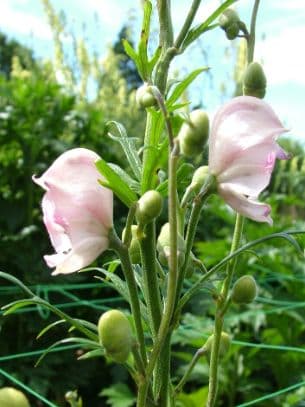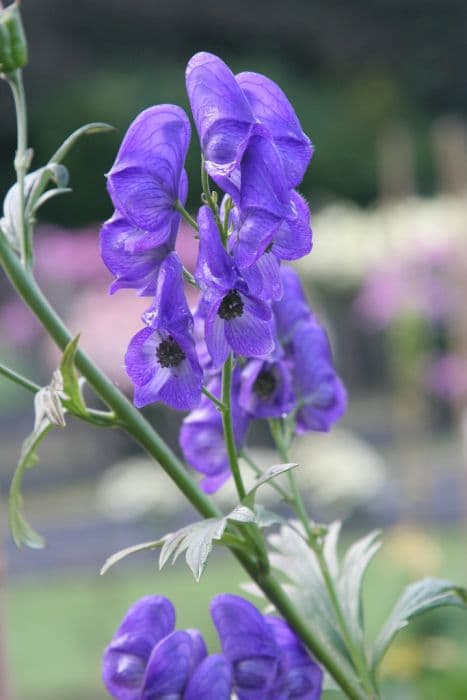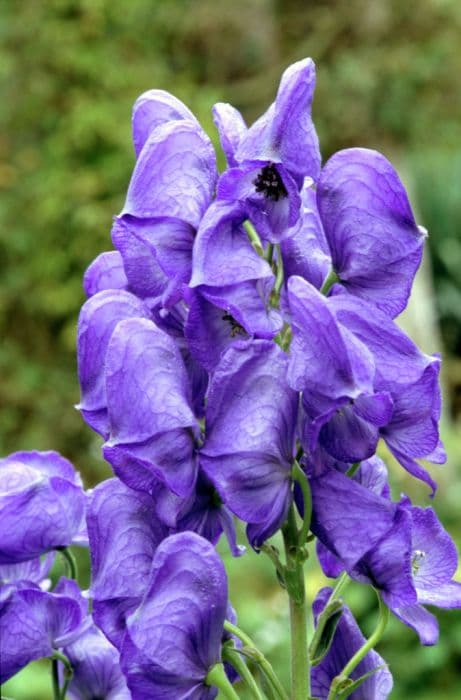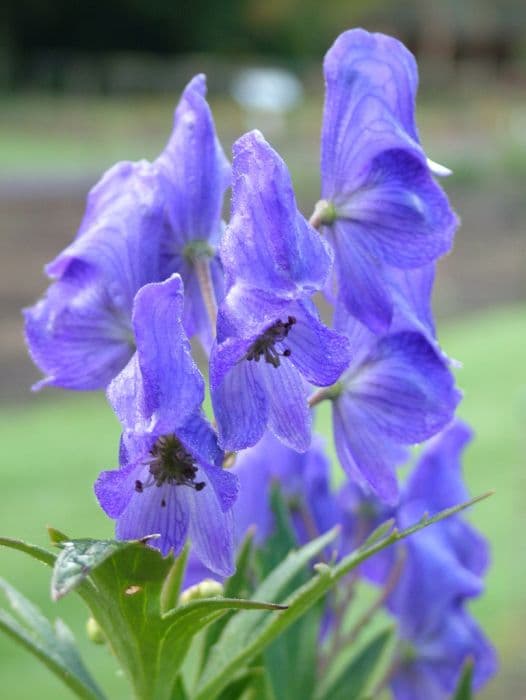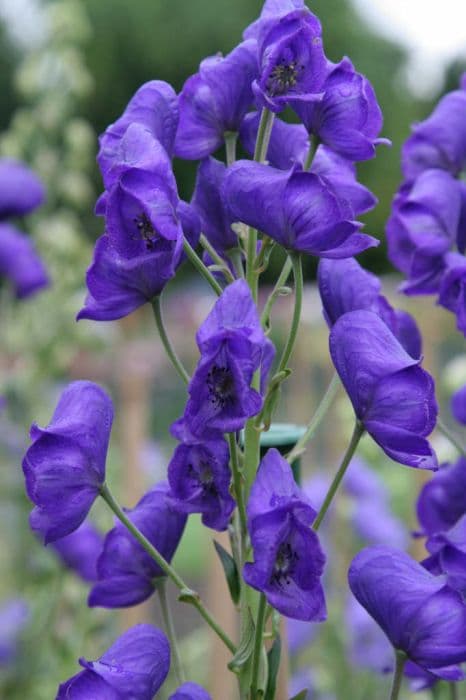Clematis Clematis 'Luxuriant Blue' (Vt)

ABOUT
Clematis 'Luxuriant Blue' is a captivating climbing plant that is best known for its stunning flowers. Its blooms are a deep, velvety blue, appearing as large, showy, star-like shapes that create a striking contrast against the green foliage. The blossoms comprise several petal-like parts that overlap slightly, giving the flowers a full, lush appearance. Adding to its flamboyance, the stamens in the center of each flower feature a creamy or pale yellow color, providing an exquisite focal point. The foliage of Clematis 'Luxuriant Blue' consists of dark green leaves, which are divided into individual leaflets. These leaflets are typically oval-shaped with a pointy tip and have a slightly toothed edge, contributing to the overall textured appearance of the plant. Together, the dramatic blooms and the verdant leaves cloak the support structures they climb, creating a wall or curtain of natural beauty. Throughout the blooming season, Clematis 'Luxuriant Blue' maintains its ornamental value, as it continually produces fresh flowers to replace those that have faded. This ensures that the plant remains attractive over an extended period, making a lasting impression in any garden or landscape where it is grown.
About this plant
 Names
NamesFamily
Ranunculaceae.
Synonyms
Virgin's Bower, Leather Flower, Vase Vine.
Common names
Clematis 'Luxuriant Blue' (Vt)
 Toxicity
ToxicityTo humans
Clematis, the common name for 'Luxuriant Blue' (Vt), is known to contain toxic compounds that can be harmful if ingested. The plant contains glycosides and irritants which can lead to mild symptoms of toxicity. Ingesting parts of this plant can cause symptoms such as nausea, vomiting, diarrhea, and excessive salivation. In rare cases or if consumed in large quantities, more severe symptoms such as internal bleeding or liver damage could occur. Contact with the sap may also cause skin irritation in sensitive individuals. It is important to handle this plant with care and ensure it is not ingested.
To pets
Clematis, the common name for 'Luxuriant Blue' (Vt), can be toxic to pets if ingested. The plant contains compounds that may irritate the mouth and gastrointestinal tract of animals. Common symptoms of clematis poisoning in pets may include drooling, vomiting, diarrhea, and in severe cases, possible seizures or tremors. It is crucial to keep this plant away from pets and to contact a veterinarian if you suspect that your pet has ingested any part of the plant.
 Characteristics
CharacteristicsLife cycle
Perennials
Foliage type
Deciduous
Color of leaves
Green
Flower color
Blue
Height
6-8 feet (1.8-2.4 meters)
Spread
3-4 feet (0.9-1.2 meters)
Plant type
Climber
Hardiness zones
4
Native area
Japan
Benefits
 General Benefits
General Benefits- Aesthetic Appeal: The Clematis 'Luxuriant Blue', commonly known as Virginia Clematis, offers stunning blue-violet flowers that can add a touch of elegance to any garden or landscape.
- Vertical Interest: This climbing vine is ideal for growing on trellises, arbors, fences, or pergolas, bringing height and vertical interest to outdoor spaces.
- Seasonal Color: With its vibrant blooms, this plant provides seasonal color and can be used to enhance the visual appeal of gardens throughout the blooming period.
- Habitat for Wildlife: The flowers of the Virginia Clematis attract pollinators such as bees and butterflies, which are beneficial for the ecosystem.
- Privacy Screen: When grown on structures, it can act as a natural privacy screen, offering a green cover that obscures unsightly views.
- Shade Provider: By covering arbors or pergolas, the Virginia Clematis can create shaded areas in the garden, providing relief from the sun during hot weather.
- Erosion Control: As a climbing plant, it can help stabilize soil and prevent erosion on slopes when planted at the base of a supporting structure.
- Versatility: This variety of clematis can be combined with other climbing plants or shrubs for mixed plantings, offering diverse textures and colors.
- Easy Care: Clematis 'Luxuriant Blue' is generally easy to care for and maintain, which is beneficial for gardeners of all skill levels.
 Medical Properties
Medical PropertiesThis plant is not used for medical purposes.
 Air-purifying Qualities
Air-purifying QualitiesThis plant is not specifically known for air purifying qualities.
 Other Uses
Other Uses- Clematis can be used in floral arrangements, where their vines and flowers provide a unique texture and color to bouquets and centerpieces.
- The vines of the Clematis can serve as natural privacy screens when grown along fences or trellises in residential areas.
- Dried Clematis vines can be woven into decorative wreaths or used in craft projects for their intricate and sturdy structure.
- In photography or art, Clematis can be the subject, affording inspiration due to its vibrant blue blossoms and lush foliage.
- Clematis can be trained to grow over unsightly features in a garden, such as old stumps or utility boxes, camouflaging them with its foliage and blooms.
- Used as a teaching tool in horticultural classes to demonstrate pruning techniques, as Clematis requires careful pruning to ensure robust growth.
- Clematis vines can be employed in theatrical settings or photo shoots as a prop to simulate an overgrown, romantic, or fantasy environment.
- This plant can be used in creating natural dye for textiles, given its pigmented petals that may yield color upon processing.
- Harvested young vines of Clematis might serve as a natural binding material in the construction of small garden structures like trellises or archways.
- The plant's climbing nature allows it to be used in vertical gardens, adding dimension and height to space-constrained urban gardens.
Interesting Facts
 Feng Shui
Feng ShuiThe Clematis is not used in Feng Shui practice.
 Zodiac Sign Compitability
Zodiac Sign CompitabilityThe Clematis is not used in astrology practice.
 Plant Symbolism
Plant Symbolism- Mental Agility: Clematis 'Luxuriant Blue', commonly known as the Clematis, often symbolizes cleverness and intellectual dexterity, as its climbing nature suggests reaching new heights in understanding or thought.
- Artistic Inspiration: The vibrant blue flowers of the Clematis are suggestive of creativity and the muse, often inspiring artists and thinkers alike with their luxurious appearance.
- Aspiration: The upward growth habit of the Clematis reflects ambition and the desire to achieve greater things, making it a symbol of aspiration and personal growth.
- Traveller's Joy: In some cultures, Clematis represents safety in travel and is often referred to as "Traveller's Joy," indicating a smooth journey and adventure.
 Water
WaterClematis, or more specifically 'Luxuriant Blue' Clematis, should be watered deeply once a week to encourage proper root growth. During the growing season, ensure that the plant receives about one inch of water weekly. If you are watering with a can or hose, this translates to roughly 0.623 gallons for each watering session. Adjust frequency to account for rainfall and remember to reduce watering in the winter months when the plant is dormant.
 Light
Light'Luxuriant Blue' Clematis thrives best in full sun to part shade conditions. It's ideal to place it in a spot where it receives at least six hours of sunlight a day. However, these plants do appreciate having their roots kept cool and shaded, so consider planting low-growing perennials or placing mulch around the base to achieve this microclimate.
 Temperature
TemperatureClematis 'Luxuriant Blue' prefers a temperate climate with temperatures ranging from around 25 to 85 degrees Fahrenheit. It can survive brief periods below freezing but sustained temperatures below 20 degrees Fahrenheit can damage the plant. The ideal growing temperature range is between 50 and 70 degrees Fahrenheit for optimal growth and bloom.
 Pruning
Pruning'Luxuriant Blue' Clematis should be pruned lightly to shape the plant and remove dead or weak stems, enhancing its vigor and flowering potential. Prune in late winter or early spring before new growth starts. This variety is in Pruning Group 3, meaning it blooms on current year's growth, so cutting back hard to about a foot above ground level can promote robust new stems and plentiful blooms.
 Cleaning
CleaningAs needed
 Soil
SoilThe best soil mix for Clematis 'Luxuriant Blue', commonly known as clematis, is well-draining soil with a neutral to slightly alkaline pH, around 7.0 to 7.5. A blend of loamy soil, compost, and perlite or gritty sand will ensure the right balance of drainage and moisture retention. Adding a layer of mulch can help maintain soil moisture levels.
 Repotting
RepottingClematis 'Luxuriant Blue' does not need to be repotted often as it is usually planted directly in the ground. If grown in a container, repotting every 2 to 3 years or when it outgrows its pot is adequate to maintain healthy growth.
 Humidity & Misting
Humidity & MistingClematis 'Luxuriant Blue' fares well in average garden humidity levels. They do not require especially high humidity, so standard outdoor conditions are generally suitable for this vine.
 Suitable locations
Suitable locationsIndoor
Ensure a sunny spot and support for climbing.
Outdoor
Plant in well-draining soil; provide sun and a trellis.
Hardiness zone
4-9 USDA.
 Life cycle
Life cycleClematis 'Luxuriant Blue', also known as Clematis viticella 'Luxuriant Blue', starts its life as a dormant vine with buds ready to burst in early spring. Upon commencement of the growing season, the perennial vine rapidly grows, climbing on supports and producing lance-shaped, green leaves. By midsummer, the plant showcases its plentiful blooms, characterized by velvety blue-purple flowers that continue to flourish through late summer. After the flowering period, the plant forms fluffy, plume-like seed heads that persist into autumn, aiding in self-seeding if conditions are right. As temperatures drop in fall, the vine's growth slows down, and the foliage starts to wither, with the plant eventually retreating back to dormancy over winter. This cycle repeats annually, with proper pruning in late winter encouraged to promote healthy new growth and abundant flowering each year.
 Propogation
PropogationPropogation time
Spring-Early Summer
Propogation: The most popular method of propagating the Clematis 'Luxuriant Blue', commonly known as Clematis, is by semi-hardwood cuttings. This process involves taking cuttings from the current season's growth that has begun to mature and harden. The optimal time for taking semi-hardwood cuttings for Clematis 'Luxuriant Blue' is late summer to early fall. The cuttings should be about 4 to 6 inches (approximately 10 to 15 cm) long with several sets of leaves. The lower end of the cutting, just below a set of leaves, is dipped in rooting hormone to facilitate root development. These prepared cuttings are then inserted into a well-draining soil mix or a rooting medium such as perlite. Maintaining high humidity around the cuttings is crucial, which can be achieved by covering them with a plastic bag or placing them in a propagator until roots develop.

